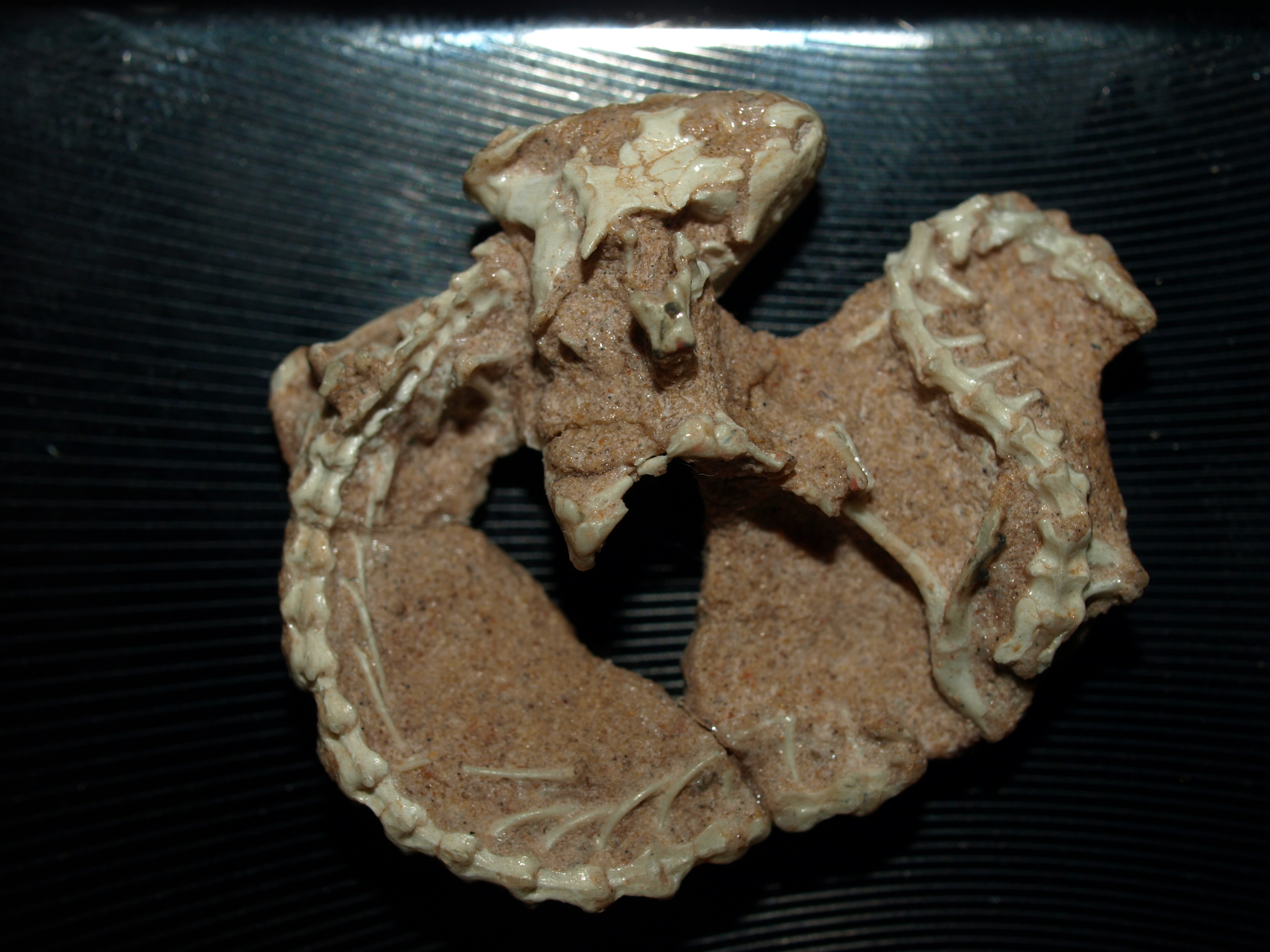|
Jacques Gauthier
Jacques Armand Gauthier (born June 7, 1948 in New York City) is an American vertebrate paleontologist, comparative morphologist, and systematist, and one of the founders of the use of cladistics in biology. Life and career Gauthier is the son of Edward Paul Gauthier and Patricia Marie Grogan. He received a B.S. degree in Zoology at San Diego State University in 1973, a Masters of Biological Science at the same institute in 1980, and a PhD in Paleontology from the University of California, Berkeley, in 1984. Currently he is a Professor of Geology and Geophysics and Ecology and Evolutionary Biology and Curator of Vertebrate Paleontology and Vertebrate Zoology at Yale University. His master's thesis, the content of which was published in 1982, is a classic work on the paleontology and phylogeny of the lizard clade Anguimorpha that remains a core reference for morphological research on Xenosauridae and Anguidae in particular. His PhD thesis constituted the first major cladistic ... [...More Info...] [...Related Items...] OR: [Wikipedia] [Google] [Baidu] |
New York City
New York, often called New York City or NYC, is the List of United States cities by population, most populous city in the United States. With a 2020 population of 8,804,190 distributed over , New York City is also the List of United States cities by population density, most densely populated major city in the United States, and is more than twice as populous as second-place Los Angeles. New York City lies at the southern tip of New York (state), New York State, and constitutes the geographical and demographic center of both the Northeast megalopolis and the New York metropolitan area, the largest metropolitan area in the world by urban area, urban landmass. With over 20.1 million people in its metropolitan statistical area and 23.5 million in its combined statistical area as of 2020, New York is one of the world's most populous Megacity, megacities, and over 58 million people live within of the city. New York City is a global city, global Culture of New ... [...More Info...] [...Related Items...] OR: [Wikipedia] [Google] [Baidu] |
Phylogeny
A phylogenetic tree (also phylogeny or evolutionary tree Felsenstein J. (2004). ''Inferring Phylogenies'' Sinauer Associates: Sunderland, MA.) is a branching diagram or a tree showing the evolutionary relationships among various biological species or other entities based upon similarities and differences in their physical or genetic characteristics. All life on Earth is part of a single phylogenetic tree, indicating common ancestry. In a ''rooted'' phylogenetic tree, each node with descendants represents the inferred most recent common ancestor of those descendants, and the edge lengths in some trees may be interpreted as time estimates. Each node is called a taxonomic unit. Internal nodes are generally called hypothetical taxonomic units, as they cannot be directly observed. Trees are useful in fields of biology such as bioinformatics, systematics, and phylogenetics. ''Unrooted'' trees illustrate only the relatedness of the leaf nodes and do not require the ancestral root to be ... [...More Info...] [...Related Items...] OR: [Wikipedia] [Google] [Baidu] |
California Academy Of Sciences
The California Academy of Sciences is a research institute and natural history museum in San Francisco, California, that is among the largest museums of natural history in the world, housing over 46 million specimens. The Academy began in 1853 as a learned society and still carries out a large amount of original research. The institution is located at the Golden Gate Park in San Francisco. Completely rebuilt in 2008, the Academy's primary building in Golden Gate Park covers . In early 2020, before the COVID-19 pandemic, the California Academy of Sciences had around 500 employees and an annual revenue of about $33 million. Governance The California Academy of Sciences, California's oldest operating museum and research institution for the natural sciences, is governed by a forty-one member Board of Trustees who are nominated and chosen by the California Academy of Sciences Fellows. The Academy Fellows are, in turn, " minated by their colleagues and appointed by the Board of Tr ... [...More Info...] [...Related Items...] OR: [Wikipedia] [Google] [Baidu] |
Squamata
Squamata (, Latin ''squamatus'', 'scaly, having scales') is the largest order of reptiles, comprising lizards, snakes, and amphisbaenians (worm lizards), which are collectively known as squamates or scaled reptiles. With over 10,900 species, it is also the second-largest order of extant (living) vertebrates, after the perciform fish. Members of the order are distinguished by their skins, which bear horny scales or shields, and must periodically engage in molting. They also possess movable quadrate bones, making possible movement of the upper jaw relative to the neurocranium. This is particularly visible in snakes, which are able to open their mouths very wide to accommodate comparatively large prey. Squamata is the most variably sized order of reptiles, ranging from the dwarf gecko (''Sphaerodactylus ariasae'') to the Reticulated python (''Malayopython reticulatus'') and the now-extinct mosasaurs, which reached lengths over . Among other reptiles, squamates are most close ... [...More Info...] [...Related Items...] OR: [Wikipedia] [Google] [Baidu] |
National Science Foundation
The National Science Foundation (NSF) is an independent agency of the United States government that supports fundamental research and education in all the non-medical fields of science and engineering. Its medical counterpart is the National Institutes of Health. With an annual budget of about $8.3 billion (fiscal year 2020), the NSF funds approximately 25% of all federally supported basic research conducted by the United States' colleges and universities. In some fields, such as mathematics, computer science, economics, and the social sciences, the NSF is the major source of federal backing. The NSF's director and deputy director are appointed by the President of the United States and confirmed by the United States Senate, whereas the 24 president-appointed members of the National Science Board (NSB) do not require Senate confirmation. The director and deputy director are responsible for administration, planning, budgeting and day-to-day operations of the foundation, while t ... [...More Info...] [...Related Items...] OR: [Wikipedia] [Google] [Baidu] |
Scincomorpha
Scincomorpha is an infraorder and clade of lizards including skinks (Scincidae) and their close relatives. These include the living families Cordylidae (girdled lizards), Gerrhosauridae (plated lizards), and Xantusiidae (night lizards), as well as many extinct taxa. Other roughly equivalent terms include the suborder Scinciformata, or the superfamily Scincoidea, though different authors use these terms in a broader or more restricted usage relative to true skinks. They first appear in the fossil record about 170 million years ago, during the Jurassic period.Evans, S.E. and Jones, M.E.H. (2010). "The Origin, Early History and Diversification of Lepidosauromorph Reptiles," pp. 27-44 in Bandyopadhyay, S. (ed.), ''New Aspects of Mesozoic Biodiversity'', 27 Lecture Notes in Earth Sciences 132./ref> The phylogeny below follows that of Alifanov in 2016. Image:Polyglyphanadon sternbergi - IMG 0694.jpg, '' Polyglyphanodon, Polyglyphanodon sternbergi'' File:Bronze Grass Skink (Mabuya ma ... [...More Info...] [...Related Items...] OR: [Wikipedia] [Google] [Baidu] |
PhyloCode
The ''International Code of Phylogenetic Nomenclature'', known as the ''PhyloCode'' for short, is a formal set of rules governing phylogenetic nomenclature. Its current version is specifically designed to regulate the naming of clades, leaving the governance of species names up to the rank-based nomenclature codes ('' ICN'', ''ICNCP'', '' ICNP'', '' ICZN'', '' ICVCN''). The ''PhyloCode'' is associated with the International Society for Phylogenetic Nomenclature (ISPN). The companion volume, ''Phylonyms'', establishes 300 taxon names under ''PhyloCode'', serving as examples for those unfamiliar with the code. RegNum is an associated online database for registered clade names. The ''PhyloCode'' regulates phylogenetic nomenclature by providing rules for deciding which associations of names and definitions are considered established, which of those will be considered homonyms or synonyms, and which one of a set of synonyms or homonyms will be considered accepted (generally the one regi ... [...More Info...] [...Related Items...] OR: [Wikipedia] [Google] [Baidu] |
Linnaean Taxonomy
Linnaean taxonomy can mean either of two related concepts: # The particular form of biological classification (taxonomy) set up by Carl Linnaeus, as set forth in his ''Systema Naturae'' (1735) and subsequent works. In the taxonomy of Linnaeus there are three kingdoms, divided into ''classes'', and they, in turn, into lower ranks in a hierarchical order. # A term for rank-based classification of organisms, in general. That is, taxonomy in the traditional sense of the word: rank-based scientific classification. This term is especially used as opposed to cladistic systematics, which groups organisms into clades. It is attributed to Linnaeus, although he neither invented the concept of ranked classification (it goes back to Plato and Aristotle) nor gave it its present form. In fact, it does not have an exact present form, as "Linnaean taxonomy" as such does not really exist: it is a collective (abstracting) term for what actually are several separate fields, which use similar approac ... [...More Info...] [...Related Items...] OR: [Wikipedia] [Google] [Baidu] |
Kevin De Queiroz
Kevin de Queiroz is a vertebrate, evolutionary, and systematic biologist. He has worked in the phylogenetics and evolutionary biology of squamate reptiles, the development of a unified species concept and of a phylogenetic approach to biological nomenclature, and the philosophy of systematic biology. Early life and Career De Queiroz was born and raised in Los Angeles, California. He received a B.S. in Biology from the University of California, Los Angeles (1978), a M.S. in Zoology from San Diego State University (1985), and a Ph.D. in Zoology from the University of California, Berkeley (1989). He was a Tilton Postdoctoral Fellow at the California Academy of Sciences and is currently a Research Zoologist and a curator of the collection of Amphibians and Reptiles at the National Museum of Natural History, Smithsonian Institution. He is a former president of the Society of Systematic Biologists and was the first president of the International Society for Phylogenetic Nomenclatu ... [...More Info...] [...Related Items...] OR: [Wikipedia] [Google] [Baidu] |
Squamate
Squamata (, Latin ''squamatus'', 'scaly, having scales') is the largest order of reptiles, comprising lizards, snakes, and amphisbaenians (worm lizards), which are collectively known as squamates or scaled reptiles. With over 10,900 species, it is also the second-largest order of extant (living) vertebrates, after the perciform fish. Members of the order are distinguished by their skins, which bear horny scales or shields, and must periodically engage in molting. They also possess movable quadrate bones, making possible movement of the upper jaw relative to the neurocranium. This is particularly visible in snakes, which are able to open their mouths very wide to accommodate comparatively large prey. Squamata is the most variably sized order of reptiles, ranging from the dwarf gecko (''Sphaerodactylus ariasae'') to the Reticulated python (''Malayopython reticulatus'') and the now-extinct mosasaurs, which reached lengths over . Among other reptiles, squamates are most close ... [...More Info...] [...Related Items...] OR: [Wikipedia] [Google] [Baidu] |
Amniota
Amniotes are a clade of tetrapod vertebrates that comprises sauropsids (including all reptiles and birds, and extinct parareptiles and non-avian dinosaurs) and synapsids (including pelycosaurs and therapsids such as mammals). They are distinguished from the other tetrapod clade — the amphibians — by the development of three extraembryonic membranes ( amnion for embryoic protection, chorion for gas exchange, and allantois for metabolic waste disposal or storage), thicker and more keratinized skin, and costal respiration (breathing by expanding/constricting the rib cage). All three main features listed above, namely the presence of an amniotic buffer, water-impermeable cutes and a robust respiratory system, are very important for amniotes to live on land as true terrestrial animals – the ability to reproduce in locations away from water bodies, better homeostasis in drier environments, and more efficient air respiration to power terrestrial locomotions, although they migh ... [...More Info...] [...Related Items...] OR: [Wikipedia] [Google] [Baidu] |




.jpg)


.jpg)